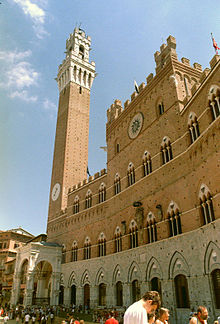Torre del Mangia
43°19′5.56″N 11°19′56.11″E / 43.3182111°N 11.3322528°E


The Torre del Mangia is a tower in Siena, in the Tuscany region of Italy. Built in 1325-1348, it is located in the Piazza del Campo, Siena's premier square, adiacent to the Palazzo Pubblico (Town Hall). When built it was one of the tallest secular towers in mediaeval Italy. At 102 m, it is now second only to Cremona's Torrazzo.
The name (meaning "Tower of the Eater") derives from its first guardian, Giovanni di Balduccio, nicknamed Mangiaguadagni for his tendency to spend all his money for food.
The upper part was realized by Agostino di Giovanni under design by one Mastro Lippo pittore, probably identifiable with Lippo Memmi.
The marble loggia, known as Cappella di Piazza, was added in 1352 as a vow for the Holy Virgin by the Sienese survivors from the Black Death. The pilaster were remade in the current form in 1378, the sculptures decorating them being executed in 1378-1382 by Mariano d'Angelo Romanelli e Bartolomeo di Tommé. The simple wooden ceiling once covering the loggia was replaced by the current Renaissance marble vault in 1461-1468 by Antonio Federighi, also author of the bizarre decorations of the coronation. In 1537-1539 Il Sodoma painted a fresco over the altar, now housed in the Town museum in the Palazzo Pubblico.
The clock was added in 1360.
The tower is visible from all parts of Siena and is adjacent to the Gothic Palazzo Pubblico.
The tower was built to be the exact same height as the Duomo di Siena as a sign that the church and the state had equal amounts of power.
The walls of the tower are approximatelty 11 ft. thick on each side. The stairwell up to the top of the tower is cramped and most visitors need to duck their heads at some point on the way up the tower. There is little room for two way traffic on the stairs, so only 25 visitors at a time are allowed to enter the tower.
Replicas
A replica clock tower designed by McKim, Mead & White can be seen in Waterbury, Connecticut in the United States. Completed in 1909 it formerly housed the city's train station, and is now headquarters to the region's local newspaper. There is also another clock tower fashioned on it called the Joseph Chamberlain Memorial Clock Tower (nicknamed Old Joe) at the University of Birmingham, Birmingham, Great Britain, completed in 1908.
The Pilgrim Monument at Provincetown, Massachusetts, designed by Willard T. Sears was built between 1907 and 1910 to commemorate the first landing of the Mayflower Pilgrims in Provincetown on November 21, 1620. The monument is the tallest all-granite structure in the United States, the design patterned after the Torre del Mangia.
Gallery
-
Detail of the upper part of the tower.
-
Ensemble view.
-
Statues on the loggia.
-
The Pilgrim Monument, Provincetown, Massachusetts, designed after the Torre.
References
Voir aussi
((commonscat | Torre del Mangia (Sienne))) * Palio di Siena
catégorie: architecture 1330s catégorie: Bâtiments et structures de Sienne Mangia
((Italie-struct-stub))




